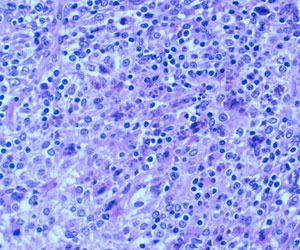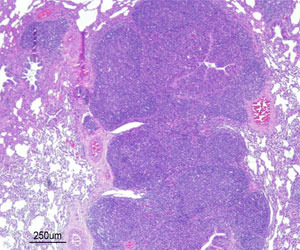Porcine circovirus type 2 (PCV2) is one of the most economically important pathogens of the swine industry. This small, ubiquitous virus is nowadays recognized as the essential causative agent of a number of diseases collectively named as porcine circovirus diseases (PCVDs). Among these PCVDs, PCV2-systemic disease (PCV-SD, formerly known as postweaning multisystemic wasting syndrome, PMWS) is the most significant one. Although PCV2 infection is necessary to cause the full spectrum of PCV-SD clinical signs and lesions (Figure 1), the disease is reproduced more efficiently when co-inoculation with other pathogens is done. One of these co-infectors is Mycoplasma hyopneumoniae (Mhyo). Mhyo is the main etiologic agent of enzootic pneumonia (EP), a chronic respiratory disease that affects mainly growing and finishing pigs. EP-like lesions are characterized by a broncho-interstitial pneumonia with broncho-alveolar lymphoid tissue (BALT) hyperplasia (Figure 2). Together with other pathogens, including PCV2, Mhyo plays a major role on the occurrence of porcine respiratory disease complex (PRDC). Consequently, diagnosis and control of such interaction between these two pathogens is of high priority for the pig producers and practitioners worldwide.
 |
 |
| Figure 1: Severe lymphocyte depletion with granulomatous inflammation of lymphoid tissues. Presence of intracytoplasmic inclusion bodies. | Figure 2: Broncho-interstitial pneumonia with broncho-alveolar lymphoid tissue (BALT) hyperplasia caused by a Mhyo experimental infection |

Under field conditions, there are several works reporting prevalence of PCV2 and Mhyo co-infected animals. Indeed, a recent field investigation found that seropositivity to Mhyo was a risk factor associated with an increased PCVD severity. However, it is important to keep in mind that infection or antibody development against these two pathogens does not imply synergistic interaction and disease development, and therefore no assumption from prevalence studies should be done on this respect. The real consequences and implications of this co-infection should be assessed under experimental conditions. Experimental Mhyo and PCV2 co-inoculations have resulted in somewhat divergent results. An experimental design consisting of naïve pigs inoculated firstly with Mhyo and two weeks later with PCV2 resulted in an overall increase of PCV2-associated lesion severity. This increased severity was attributed to the ability of Mhyo to up-regulate macrophage proliferation and, therefore, to facilitate PCV2 replication, together with an alteration of cytokine mRNA expression profiles. On the contrary, the concurrent and simultaneous inoculation of Mhyo and PCV2 in seropositive pigs did not result in such synergetic results. These divergent results probably could be explained due to several differences in the experimental design (table 1). Therefore, potentiation of PCV2-induced lesions by Mhyo infection may occur but depends on several factors.
Table 1: Differences on experimental design between two Mhyo and PCV2 co-infection models that yielded different results.
| Opriessnig et al., 2004 | Sibila et al., 2012 | ||
| Age at inoculation | Mhyo | 4 weeks of age | 6 weeks of age |
| PCV2 | 6 weeks of age | 6 weeks of age | |
| Source of animals | Seronegative to both pathogens | Seropositive to both pathogens | |
| Strain nature and dose of Mhyo inoculum | Strain 232 tissue homogenate 105 CCU/ml | Strain 98 fresh culture 106 CCU/ 5 ml first day 109 CCU/ 5 ml second day | |
Potentiation of PCV2-induced lesions had also been attributed in several field and experimental studies to immune system stimulation. Firstly, Mhyo vaccination was pointed out as one these stimulators that may enhance PCV2 replication. Secondly, this stimulation was attributed to specific vaccine adjuvants rather to the vaccine itself. In order to avoid the putative PCV2 replication enhancement, it has been recommended to vaccinate against Mhyo before PCV2 circulation. For example, it has been observed under experimental conditions that Mhyo vaccination between 2 and 4 weeks prior PCV2 exposure does not cause PCV2-SD lesion potentiation.
Vaccination strategies against these pathogens have followed more or less the same evolution, from two doses to one single dose. Besides, the fact that PCV2 and Mhyo vaccination may coincide in time has raised the question whether these two vaccines could be applied simultaneously or combined at the same age. This strategy would diminish the labor and the stress on animals. However, in such scenario efficacy of both vaccines should be again re-evaluated. Nowadays, peer-reviewed studies comparing the efficacy of combined versus simultaneous vaccination strategies are lacking and therefore scientific conclusions are difficult to be drawn.
After several years of administration, capability of PCV2 and Mhyo vaccines to reduce lesion severity and production parameters improvement have been vastly worldwide demonstrated. However, results of some recent field studies suggest that administration of some nursery pig vaccines (like these two ones) may affect pig performance immediately after weaning (reduced feed intake and reduction of growth rate). Nevertheless, in a pathogen exposure scenario this immediate but transient negative vaccine effect should always be balanced against the benefits of vaccination during the entire production cycle.





